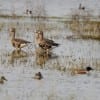 By Jim Stevenson
By Jim Stevenson
First, my book “Birds of Galveston” is at the printers as of last Thursday and is being printed. I will begin mailings this weekend when I have them in hand. To order, IF YOU HAVEN’T, just send me you address via e-mail, as always. THEN, send me a check WHEN YOU RECEIVE IT. It’s $40. I am dealing with this book first, then electronic versions and a tabletop edition (very expensive!) later. Second, if you are going on the Costa Rica, Rio Grande Valley or Venezuela trip, PLEASE send me (at least) a deposit, made out to the GOS, so I can feel comfortable about making hotel arrangements. GOS, Rt. 1 Box 185C, Galveston, TX, 77554.
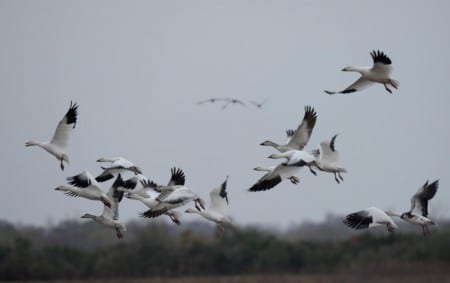
Waterfowl are loosely divided into three major groups: The huge swans, the fairly large geese and the smaller ducks. Swans are white without the black wingtips you see in these Snow Geese, geese are good-sized with a love for browsing along shorelines, often out of the water, and ducks are smaller, more diverse and aquatic, plus divided into several distinct groups. There is more diversity in this picture than you may think! Yes, they are largely Snow Geese, but did you see the three cranes in the far-off middle? OK, how about the far right bird, which is a cross between the dark and light morph of the Snow Goose? And did you see the immature Snow Goose (dusky below) on the lower left? But the real prize is the Ross’s Goose in the middle of the right clump, much smaller than the three adult Snows behind it. And a tidbit, did you see the far left bird calling?
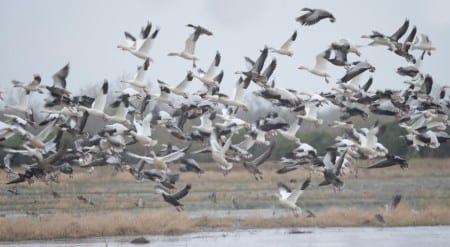
Now you can see the dark morph Snow Geese easily, constituting about 35% of this flock. Most are adults, with a white head, but if you look carefully you can see some all-dark ones which are immatures. These dark morph Snow Geese were considered a separate species for many years, called the Blue Goose, before it was decided they were a dimorphic species (two possible colors). There are also ducks in this picture. Top middle there’s a male Mallard airborne on this dark, gray day, not too terribly smaller than the geese. Much smaller, though, are the Green-winged Teal (and perhaps others) below the flock. These geese are probably just hanging out, not feeding, but the teal were likely foraging. These freshwater (dabbling) ducks take off the way geese do, straight up off the water
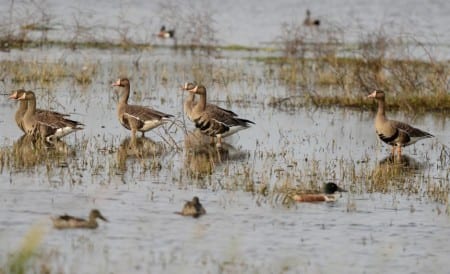
The other “non-Canada” Goose is the White-fronted, or “specklebelly,” as some folks like hunters call them. Their pink bill & legs and white face combine with the black underneath on adults to make them very easy to separate from other geese. Canadas are brown but lack the above field marks, and immature “blue” geese are more of a charcoal color. Geese really aren’t very hard to identify. Winter is a great time to see geese in places such as the refuges on the UTC. Three shovelers are paddling along in front, with a (I think) an American Wigeon in the back middle, to the left of the male Gadwall top right. Gray duck, black butt. Male shovelers don’t generally achieve full breeding plumage until late winter, and their fall eclipse plumages (males) late summer into winter are horrendous. Shovelers become even tamer than other ducks. This is possibly from not being hunted much, owing to their diet causing their meat to be distasteful. A great recipe, however, is to cook them in veggies, throw away the duck and eat the veggies. Below are pictures of flying Black-bellied Whistling-ducks on the next page (note the white wingstripe), and Fulvous Whistling-ducks on the following page. Fulvous means tawny, and they lack bold markings like the BBWD has. BBWDs are residents on the UTC but Fulvous are scarce, mostly seen in early spring migrating to Louisiana. These two are part of a larger tropical group of whistling-ducks, sometimes still called by their former name, “tree ducks.” Not all the countries have gotten the memo. This group has longer legs and necks than many ducks and squeals rather than quacking. They are relatively recent immigrants into North America, and coming from the New World Tropics, they are not the winter residents that most northern-nesting waterfowl are.
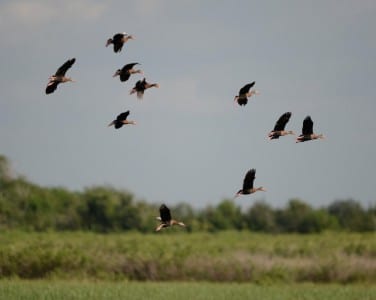
Bottom and top of flying Black-bellied Whistling-ducks. Fulvous Whistling-ducks, seen most frequently in early spring flying circum-Gulf.
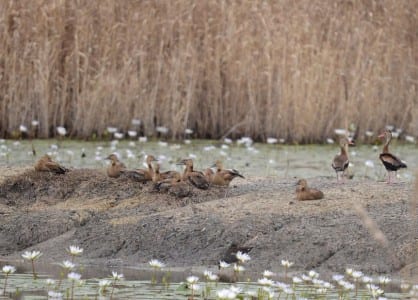
Most seasoned birders doubt they make many mistakes in bird identification, but when I have been in the field with other excellent birders, little things happen that demonstrate us missing more than you might think (or THEY might think!). I glanced out on this flock (the birds on the left) and assumed them to be Fulvous Whistling-ducks, as they certainly seemed the correct color for that species. Then I took a second look and saw the pair of Black-bellied Whistling-ducks to their right, and it hit me. Oops. Those are young BBWDs without all the color, tawny brown with gray bills. And may I say those parents deserve a lot of credit for raising that many chicks to adult size, against all odds. OK, question. Did you see the Common Gallinule down below, in the lilies? It’s right in the middle, but easy to miss because we’re concentrating on the ducks. I not only wonder how many mistakes us “professional” birders make and never catch, but also how many birds we all miss because we don’t see them.
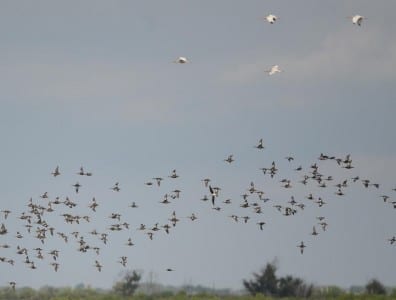
This is an interesting flock of ducks. It is dominated by Blue-winged Teal, a common winter resident and abundant spring/fall migrant on the UTC. What else do you see? Go ahead and take a look. BTW, what other duck species have this blue on the leading edge of the wing? Not a speculum, but on the FRONT edge of the wing… (see bottom) OK, first of all, there are four adult White Ibis flying over on the top right. Second, there’s a Boat-tailed Grackle sailing along on the bottom middle, a very common bird in marshy refuges. And last, a bit of a surprise, a late Black Tern wheeling almost dead center in the flock of teal. Along with these Blue-winged Teal, Northern Shoveler have blue patches in front of their specula (secondaries), very much like BW Teal. And for you western birders, Cinnamon Teal do as well. Cool, huh?
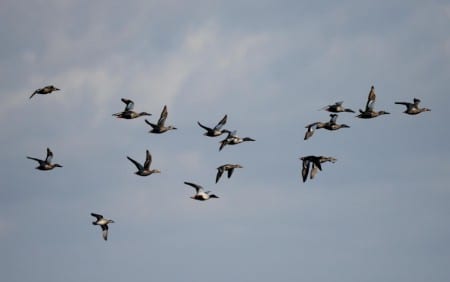
Oh, gee, lookie here. A passing flock of shovelers shows off the chalk-blue front of the inner wing, exactly like BW Teal (this is true of males and females, all three species). Three males that have already achieved breeding plumage are in the middle, a bit early for that species to have “full” drakes. And kudos for you if you noticed that the lower left duck is a female Blue-winged Teal, a species frequently flocking with shovelers.
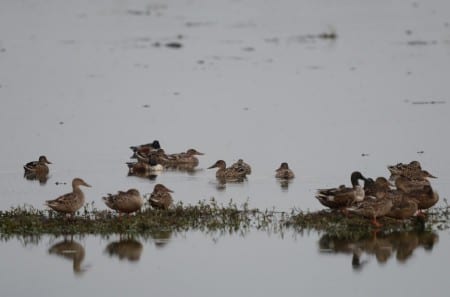
Here’s an up-close flock of shovelers sitting around talking about hunters, bird watchers and returning home to nest. (Or maybe about their quack doctors.) You can see the long bill, reminiscent of spoonbills, or even the large bill of the Canvasback, though for a very different purpose. This close you can see the males are not in full breeding regalia.
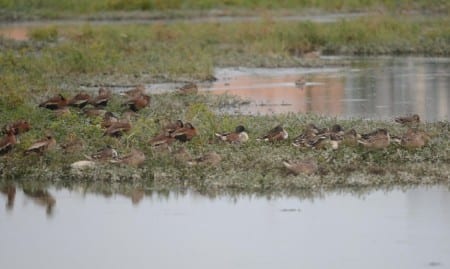
It is interesting to see shovelers and BBWDs together, given where they come from. The name “Northern” certainly applies to shovelers, as they breeding all the way to the Arctic Ocean, along with other dabbling ducks like Northern! Pintail, Mallard, Green-winged Teal, American Wigeon and occasionally other strays. Older field guides, especially, may not show the northward push many species have made into extreme northern Alaska as the Planet warms slightly. But with these Northern Shovelers are BBWDs, relatively recently having moved up through Central America and colonized Texas (especially) and elsewhere. They and the Fulvous WD have likely responded to an increase in their population, global warming, or both, along with a huge number of North American species whose ranges have displaced northward over the past several decades. I am unaware of any which have moved south.
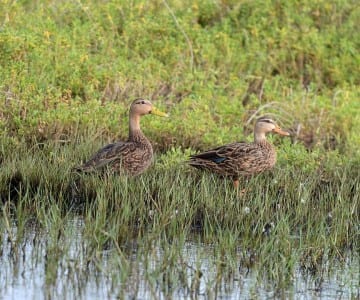
This is a lovely pair of full-blooded Mottled Ducks, a species curiously absent the bright colors of most male species. About the only sexual dimorphism is the bill color, orange with a dab of black in females and pea green in males. Males do tend to be a bit larger and darker than hens, but this picture doesn’t show that so much. Interesting how many species of birds have dark lines through the eyes, although most of those are predators, throughout the vertebrate world. In the breeding season Mottled Ducks (and countless other species) catch insects for their young. Do their young have these dark lines?
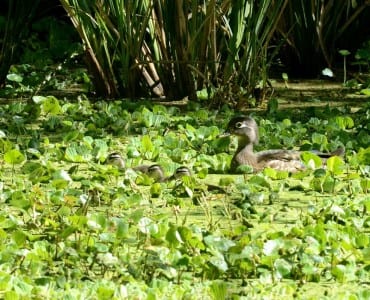
Wood Ducks are rare in my county but regular in some places in Brazoria Cnty and East Texas. This species nests in swamps; which by definition means aquatic areas with trees. Marshes are open wetlands with grass-like vegetation. Therefore, Brazos Bend State Park has Wood Ducks, although they are not seen easily. I took this last spring just before leaving so I’ve never used it. Note the dark lines through the eyes of the ducklings. This species is closely-related to the Mandarin, an Asian bird often seen domestically in our zoos and stuff.
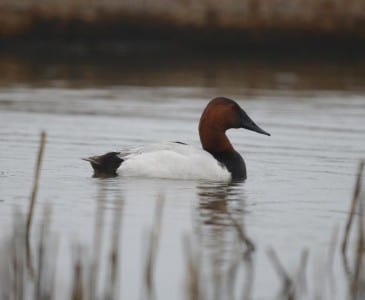
Diving ducks are quite different from these dabbling (or “puddle”) ducks. They are heavier (for diving) so they ride lower in the water. They feed on vegetation and some invertebrate life like clams on the bottom, so their meat is gamey and not preferred by hunters. They are also seen paddling across the water to take off, on account of their heavier bodies. This species is the Canvasback, one of two species having a reddish head as males. The light back gives this species its name, and the long-sloping profile is an excellent field mark. Several diving ducks have suffered cuts in their population, such a these, both scaups and the next species.
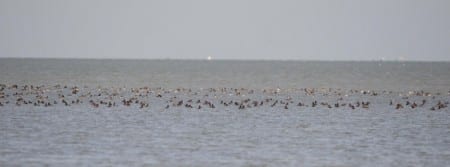
Looking at this flock of Redheads, it’d be hard to imagine them struggling as a species! They have been historically known as abundant winter residents in the Laguna Madre in southern Texas (like off of Laguna Atascosa NWR) but very recently they have wintered in modest numbers in West Bay, and even SUMMERED there! Five birds in a pond on the West End of Galveston Island. Canvasbacks, Redheads and the Ring-necked Duck of freshwater lakes all have gray wingstripes, while both scaups have much white in their wingstripes. Your field guide will show you the identificational importance of that.
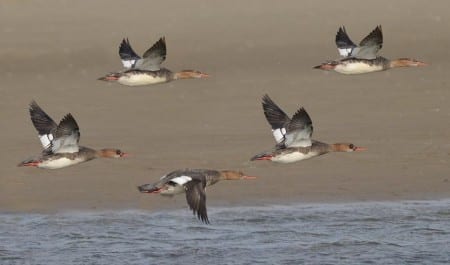
Mergansers are our only fish-eating ducks, armed with long, serrate beaks. These are Red-breasted Mergansers, by far our most common species. The males go through an eclipse plumage in fall and early winter and I believe the lower right and left birds are males in drag (note the green around the eye). Due to their fishy diet, mergansers are poor table fare and generally not hunted.
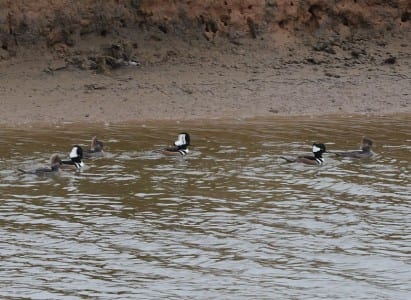
Hooded Mergansers are normally seen only rarely in our area, and their presence is often in drought years, in association with other swamp birds such as Rusty Blackbird, wood¬cock, Golden-crowned Kinglet and a couple others. However, these were in Brazoria County Saturday, 12/7, and this is clearly a very wet fall. You might wish to review their differences with Buffleheads, usually seen in our area around oyster bars, often in association with Common Goldeneye.
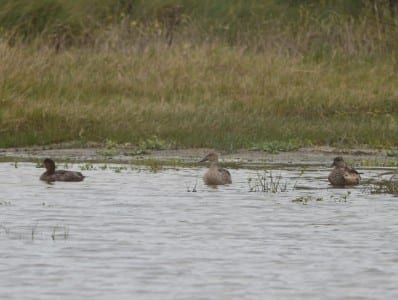
Now, just for your own edification, here are three female ducks I shot down on Follet’s Island 12/7 with clients. Hens are tough IDs without their hubbies around. If you want to work on them, I’ll post the answers on the next article. If you wish to work on these and submit results of serious work, feel free, but I don’t really want to look over a bunch of wild guesses. But if you really try, and put some time into it, I am more than happy to look over your results. I will apprise you if you get them all right, but otherwise, you’ll find out next time.

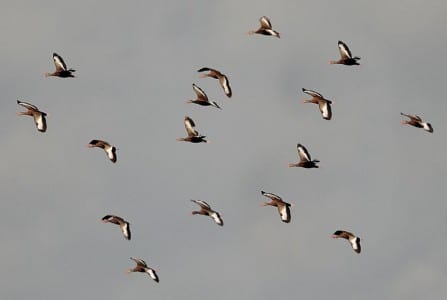
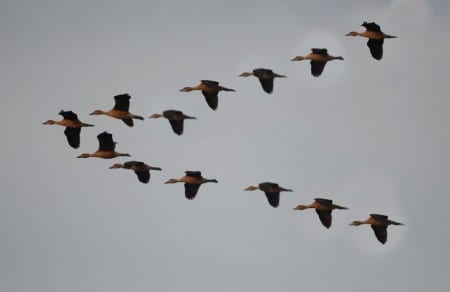
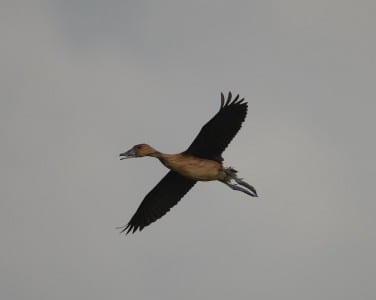
 Posted in
Posted in 
























I would like to purchase your book. Indeed your email address. My address is112 Trailwood Texas 75904 . Please contact me if you need more info at above email or address
Thank you
John
How do I send my email to you in order to purchase the book?
I would love to purchase your book.